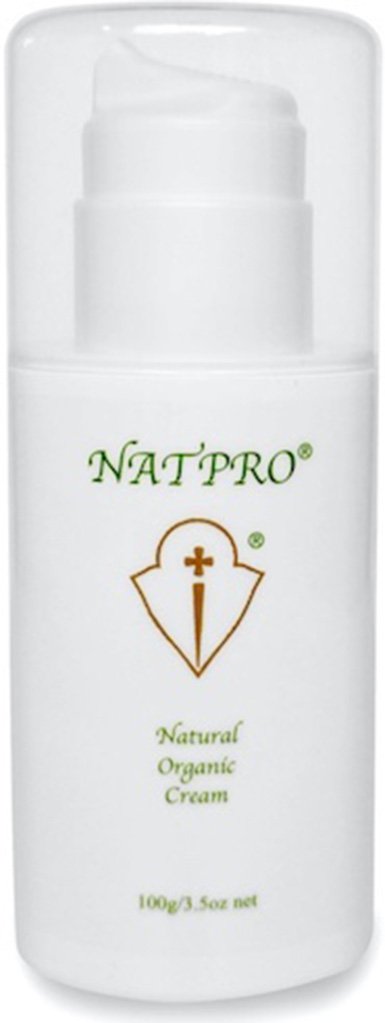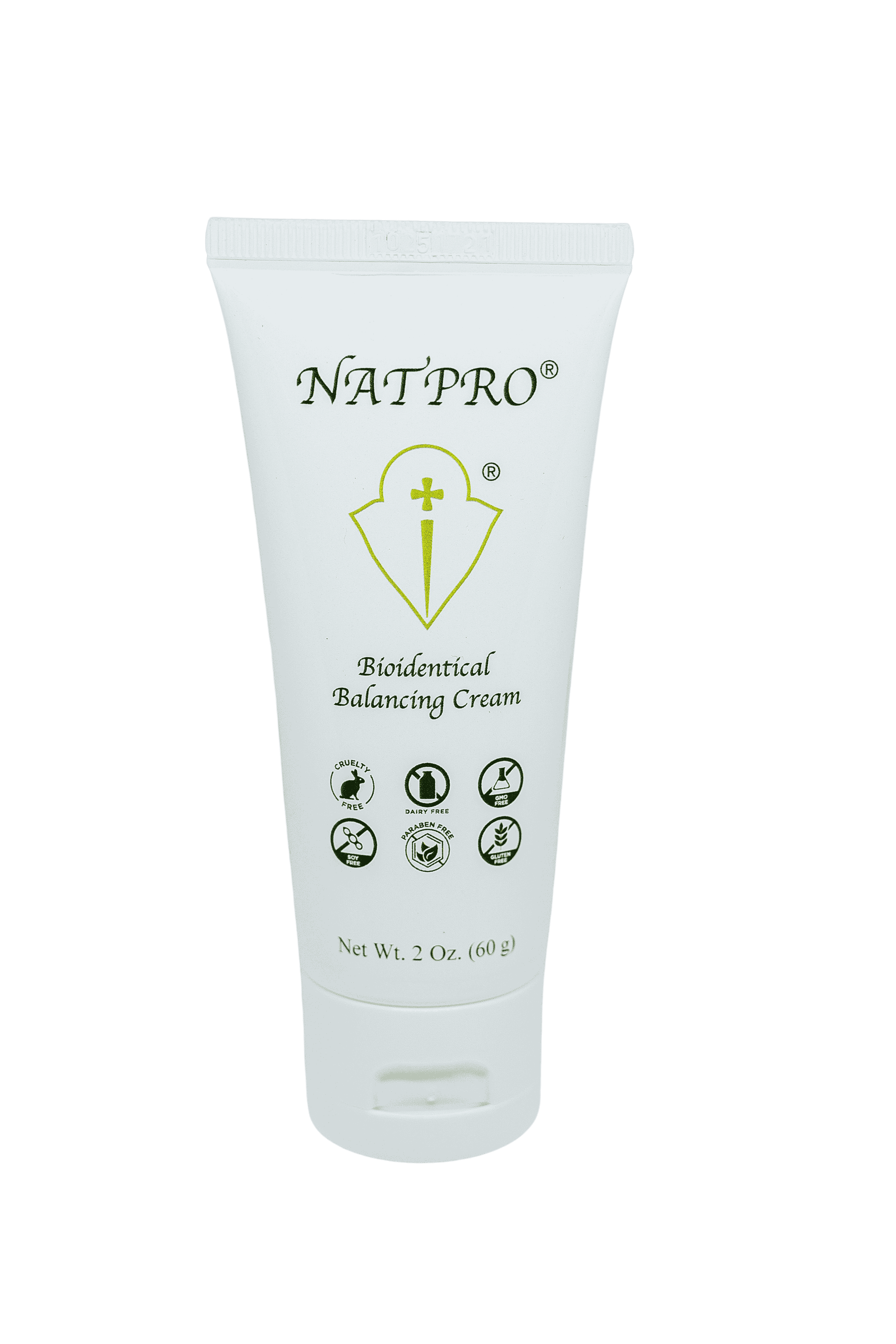Progesterone Blog
Apr 14, 2025
Dosage of progesterone for anxiety
I had a hysterectomy a year ago and have been on 1/2 to 1/4 teaspoon progesterone cream, twice a day. No other hormones, only supplements. I am post menopausal
Mar 29, 2025
No period after 14 days of progesterone
Hi, I have been taking Ona’s 20% 100mg x 2 daily. I’ve had lots of issues that have been on going since having the copper iud (now removed) when I had
Mar 27, 2025
Progesterone withdrawal?
I have been on progesterone for close to three years now (and recently have went off of it). I was taking 75mg (but was having weird symptoms and found
Mar 21, 2025
Colposcopy
Almost 40 on 200mg progesterone for close to a year with magnesium, d3 and k. Had abnormal pap recently and they want colposcopy—- now suddenly bleeding
Mar 03, 2025
Treatment for Postpartum Anxiety/Depression/OCD
I have found this website after a deep dive into progesterone as treatment for postpartum mental health disorders and an so grateful for all the information
Continue reading "Treatment for Postpartum Anxiety/Depression/OCD"
Feb 28, 2025
Perimenopause and Insomnia
Hello, I'm 51 and have had very irregular cycles for last 2 years and during this time some very heavy/long bleeds. Also many cycles way too short. Started
Feb 21, 2025
Breast cancer
My mom died of breast cancer and my aunt has it …I have some Lumps in my breast I got checked today and the gyno said she wasn’t crazy about me using progesterone
Feb 16, 2025
Why would progesterone shrink small but not large fibroids?
Hello, I am 56 year old and have a large 13 cm uterine fibroid. Reading about progesterone therapy, I would really like to try it..Many comments state
Continue reading "Why would progesterone shrink small but not large fibroids?"
Jan 22, 2025
Castor Oil
I've been using 200mg progesterone cream for probably almost a year now. I still seem to have some estrogen dominance....I also supplement with vitamin
Jan 14, 2025
Adenomyosis fibroid, polyp, Dr. Prescribed Biest w/ progesterone?
I am 49 and have been suffering with extremely heavy periods for 9 years. I also have a huge list of perminopausal/Estrogen dominent symptoms - very sore
Continue reading "Adenomyosis fibroid, polyp, Dr. Prescribed Biest w/ progesterone?"
Jan 12, 2025
Would you trust this brand of bio identical progesterone?
I am confused as I can’t find the company’s website or contact number. I asked in the estrogen dominance support Facebook group, and some people thought
Continue reading "Would you trust this brand of bio identical progesterone?"
Jan 07, 2025
New Stabilising Agent
The stabilising agent in our new Natpro tubes ‘dehydroxanthan gum’ has been changed to ‘Xanthan Gum (and) Lecithin (and) Sclerotium Gum (and) Pullulan)’
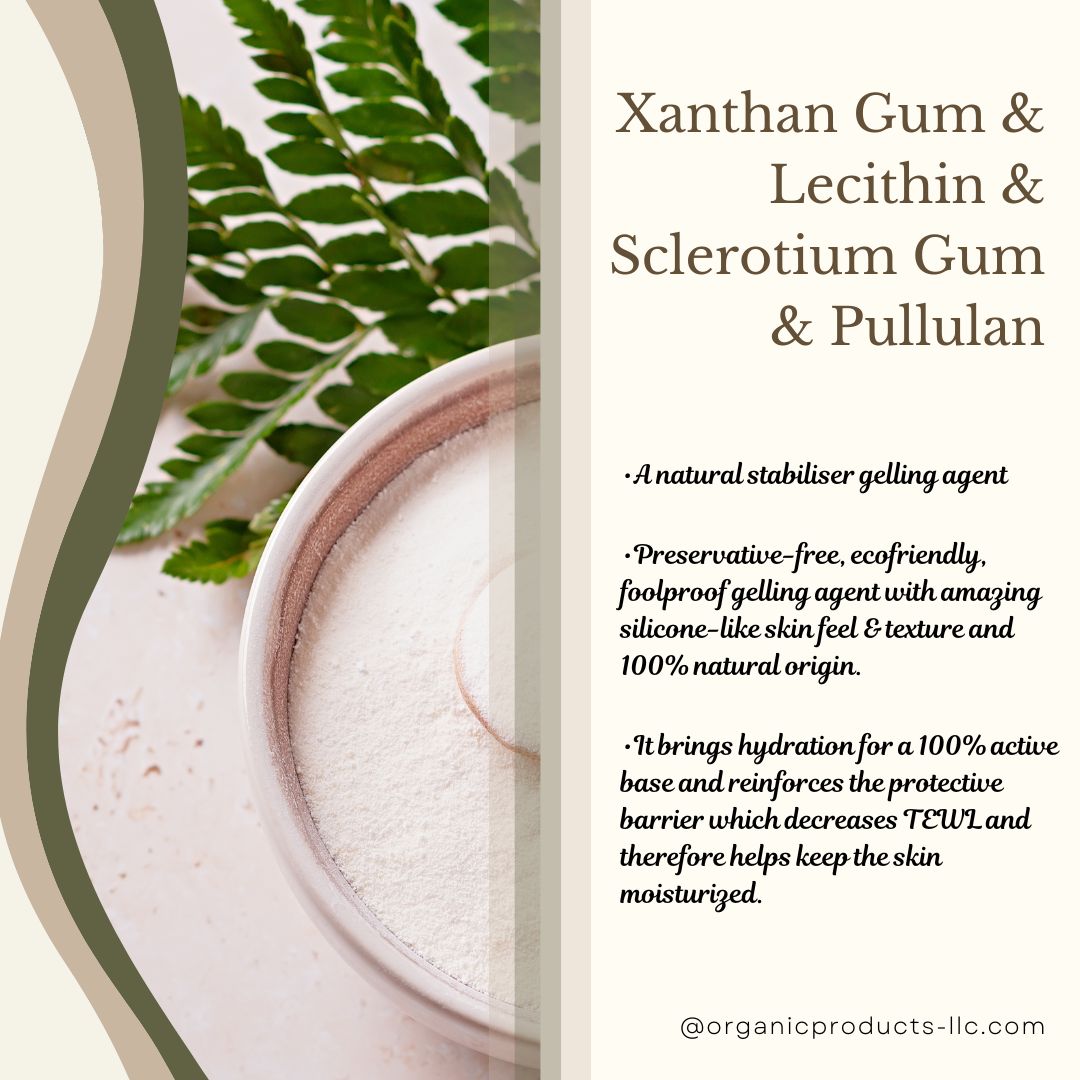
Patented optimised combination of phospholipids and polysaccharides, this is a natural stabiliser gelling agent that leaves an amazing silicone-like skin feel.
It is a preservative-free, ecofriendly, foolproof gelling agent with amazing silicone-like skin feel & texture and 100% natural origin. Also, serves as a thickener, co-emulsifier, stabilizer, suspending agent and skin feel enhancer. This green processed ingredient shows high compatibility with electrolytes.
This senso-active functional ingredient improves active ingredient efficacy and offers skin hydration for true active textures. It provides softness properties demonstrating highly attractive sensory identity. It brings hydration for a 100% active base and reinforces the protective barrier which decreases TEWL and therefore helps keep the skin moisturized.
_______
Dec 19, 2024
Katie
ENDOMETRIAL HYPERPLASIA. Has anyone successfully treated this condition with progesterone cream with lasting effects? I am booked for a hysterectomy so
Dec 15, 2024
Itchiness and Psoriasis on legs
I'm 46, have used 400mg of natpro daily for many months now (I live in extreme stress due to personal circumstances), and only in the luteal phase for
Dec 10, 2024
Sodium Olivoil Glutamate
The emulsifier in our new Natpro 60ml tubes remains olive oil based but has been changed from ‘cetearyl olivate/sorbitan olivate’ to ‘sodium olivoil glutamate'.
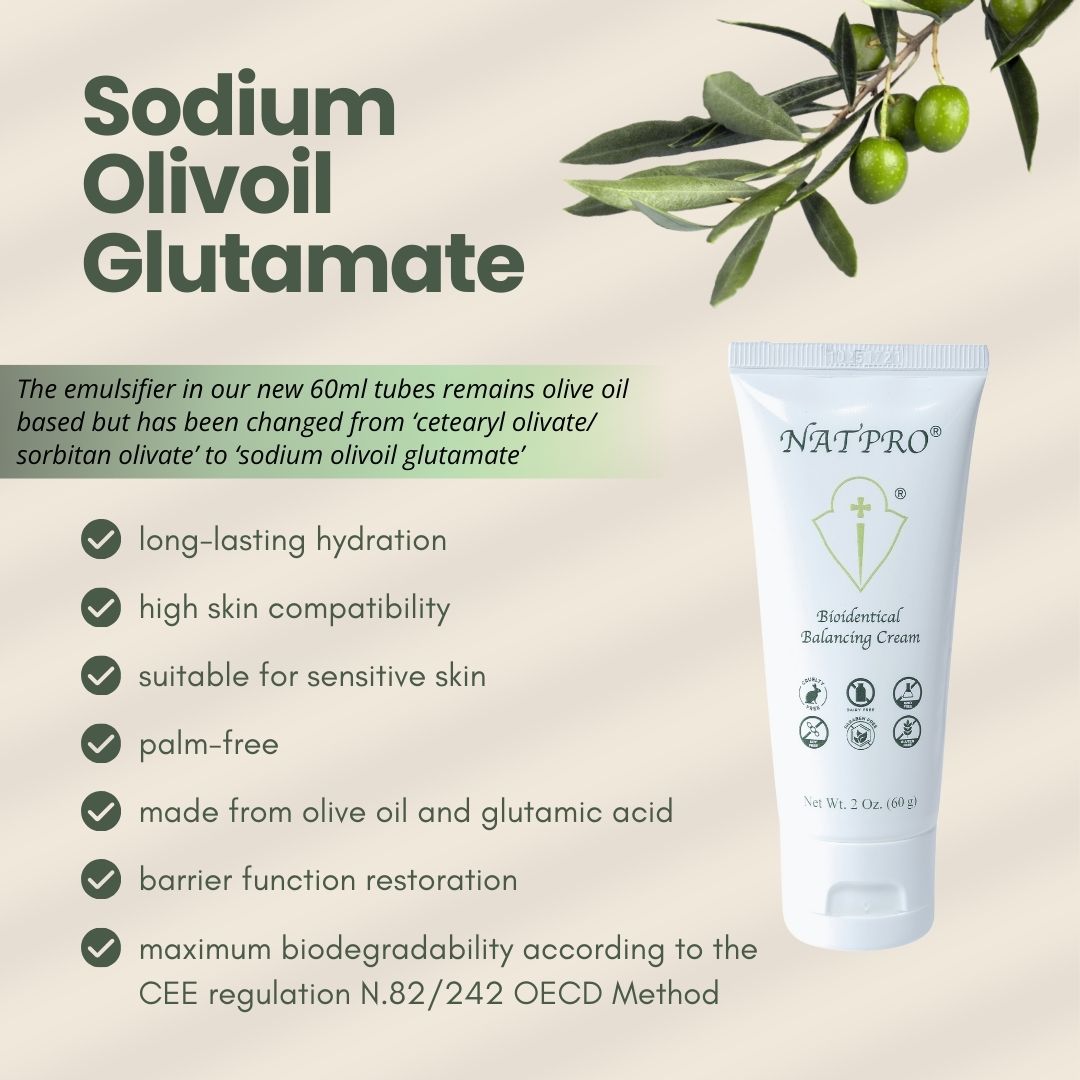
Sodium OLIVOIL Glutamate is a non-ethoxylated, vegetal derived surfactant that combines the unique fatty acid profile of olive oil with the characteristic affinity of glutamic acid toward the skin surface.
The quest for PEG-free emulsifiers led to the creation of new classes of base ingredients, one of which is this skin-friendly and environmentally-friendly Sodium OLIVOIL Glutamate.
This new emulsifier structure provides:
•high skin compatibility.•suitable for sensitive skin as well as babies or children’s skin.•protecting, soothing and restoring functionality.•maximum biodegradability according to the CEE regulation N.82/242 OECD Method.
As the whole concept of creating a more efficient equilibrium between ones skin and ones body has increased in popularity, we are seeing an increased success with ingredients of natural origin, embracing the concepts of respect for your skin, or skin friendly emulsifiers.
This is due to 2 main aspects:
1. The need for developing formulas as much as possible compatible with the physiology of skin and its annexes, without any adverse effect or allergic potential.
2.The growing confidence of consumers in the beneficial properties provided by complex mixtures of natural ingredients.
Visit our store at Organic Products.
__________
Dec 10, 2024
Sodium Olivoil Glutamate

The emulsifier in our new Natpro 60ml tubes remains olive oil based but has been changed from ‘cetearyl olivate/sorbitan olivate’ to ‘sodium olivoil glutamate'.
Sodium OLIVOIL Glutamate is a non-ethoxylated, vegetal derived surfactant that combines the unique fatty acid profile of olive oil with the characteristic affinity of glutamic acid toward the skin surface.
The quest for PEG-free emulsifiers led to the creation of new classes of base ingredients, one of which is this skin-friendly and environmentally-friendly Sodium OLIVOIL Glutamate.
This new emulsifier structure provides:
•high skin compatibility.•suitable for sensitive skin as well as babies or children’s skin.•protecting, soothing and restoring functionality.•maximum biodegradability according to the CEE regulation N.82/242 OECD Method.
As the whole concept of creating a more efficient equilibrium between ones skin and ones body has increased in popularity, we are seeing an increased success with ingredients of natural origin, embracing the concepts of respect for your skin, or skin friendly emulsifiers.
This is due to 2 main aspects:
1. The need for developing formulas as much as possible compatible with the physiology of skin and its annexes, without any adverse effect or allergic potential.
2.The growing confidence of consumers in the beneficial properties provided by complex mixtures of natural ingredients.
Visit our store at Organic Products.
__________
Dec 06, 2024
how to know when to increase or decrease
Good day. I have been using Natpro for a couple of years. I am post menopausal. I was on HRT for 7 years. 2 years ago I started by replacing the progesterone
Dec 04, 2024
We have added nicotinamide (vitamin B3)!
🌿We have added ‘nicotinamide’ (vitamin B3) to our trusted formula in our New 60ml Tubes!
🌿Read on to discover the benefits...
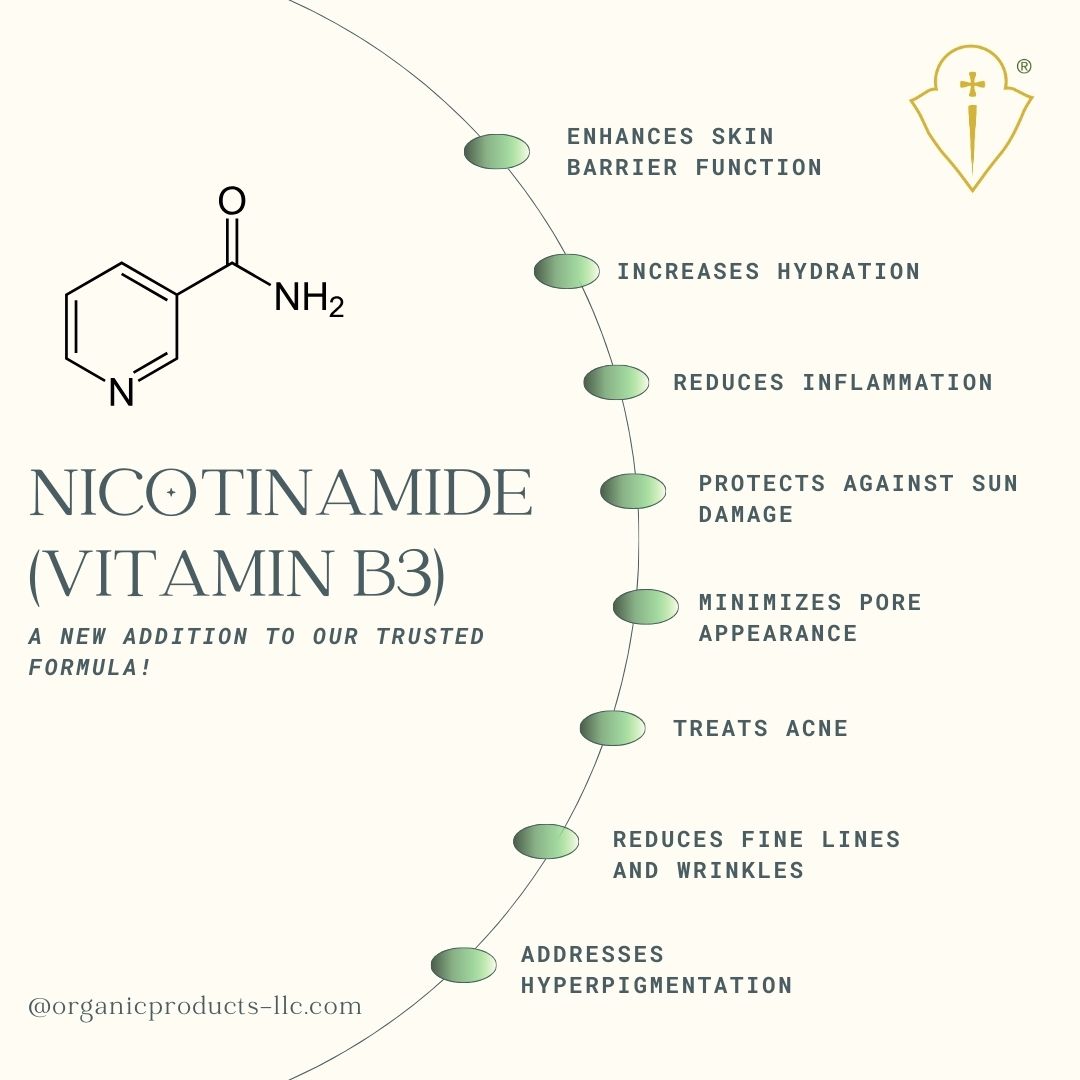
Nicotinamide, also known as niacinamide, is a form of vitamin B3 that offers numerous benefits for skin health.
Key Benefits of Nicotinamide for Skin:
🌱 Enhances Skin Barrier Function... Nicotinamide helps build keratin, a protein essential for maintaining skin health. It strengthens the skin's lipid barrier, which locks in moisture and protects against environmental irritants, making it beneficial for all skin types, particularly those with conditions like eczema and rosacea.
🌱 Reduces Inflammation... This ingredient is known for its anti-inflammatory properties, which can help calm redness and irritation associated with acne, rosacea, and other inflammatory skin conditions. By reducing inflammation, nicotinamide can improve overall skin tone and texture.
🌱 Minimizes Pore Appearance... While it does not physically reduce pore size, nicotinamide can help minimize their appearance by keeping the skin smooth and regulating oil production, which prevents clogged pores and breakouts.
🌱 Treats Acne... Nicotinamide has been shown to be effective in treating acne vulgaris. Clinical studies indicate that topical nicotinamide gel can be as effective as traditional topical antibiotics in reducing acne lesions. Additionally, it decreases sebum production, which contributes to acne development.
🌱 Addresses Hyperpigmentation... Research suggests that formulations containing 5% nicotinamide can lighten dark spots and improve skin tone over time. This effect is attributed to increased collagen production and improved skin texture.
🌱 Protects Against Sun Damage... Nicotinamide enhances the skin's ability to repair DNA damage caused by UV exposure and may reduce the risk of certain types of skin cancer in high-risk individuals. However, it should not be used as a substitute for sunscreen.
🌱 Reduces Fine Lines and Wrinkles... Topical application of nicotinamide has been linked to improvements in fine lines and wrinkles due to its ability to stimulate collagen production and improve skin elasticity. Studies have reported significant improvements in signs of aging after consistent use over several weeks.
🌱 Increases Hydration... Nicotinamide helps reduce transepidermal water loss (TEWL), thereby increasing hydration levels in the upper layers of the skin. This makes it particularly beneficial for dry or dehydrated skin types.
_______________
Dec 03, 2024
Cream Percentages
It is important to know the percentage of progesterone in the cream you choose to use...
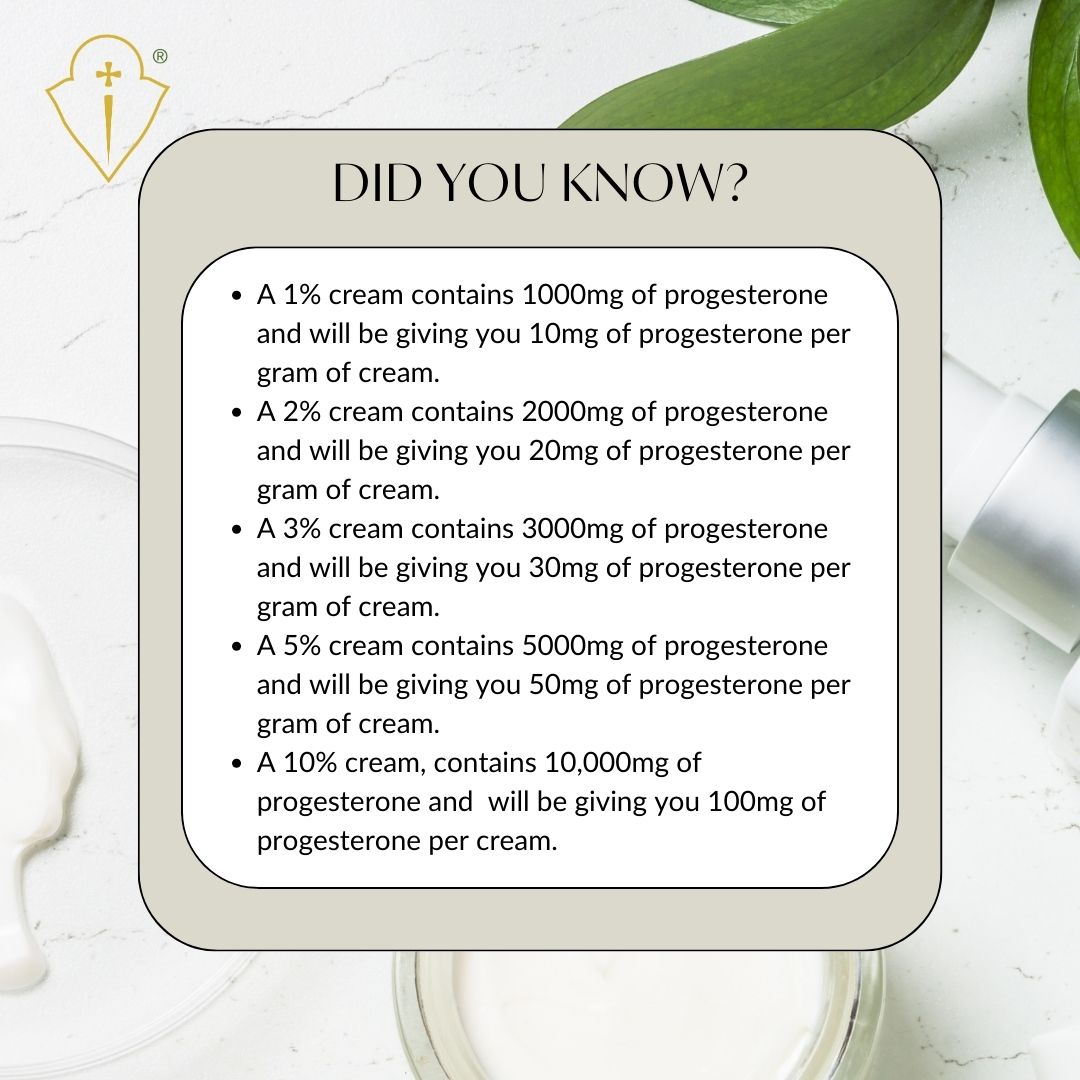
You will be administering a different quantity of progesterone per gram of cream depending on the percentage strength of the progesterone in the cream.
For example Natpro is a 3.33% cream which means it has a concentration of 3333mg of progesterone. So for every gram of Natpro cream you are getting 33.33mg of progesterone.
***
Nov 28, 2024
Natpro Black Friday Sale!!

Just in time for Black Friday!
15% off our New Natpro Tube!
To take advantage of this launch offer please copy this coupon code…
natpro15
…then paste it into the ‘coupon code’ field on the order form after you click the ‘Add to Cart’ button.
The coupon is valid right now and expires midnight Saturday 30th November.
***
Nov 27, 2024
NEW Natpro 60ml Tubes!!

🌿Reintroducing the Natpro 60ml Tubes!🌿
Due to countless requests for our tube option we are very happy to announce that we have brought it back into the Natpro family!
Not only are we re-launching it right now but we have introduced three modifications to the long established Natpro formula each of which bring small but meaningful improvements enhancing efficacy without changing the concentration of natural progesterone which remains at 3.33%.
Here are the modifications…
1• The emulsifier remains olive oil based but has been changed from ‘cetearyl olivate/sorbitan olivate’ to ‘sodium olivoil glutamate’
2• The stabilising agent ‘dehydroxanthan gum’ has been changed to ‘Xanthan Gum (&) Lecithin (&) Sclerotium Gum (&) Pullulan)’
3• We have added ‘nicotinamide’ (vitamin B3)
Read up on our formula modifications here.
Thank you for your continued support, we look forward to your feedback on the new tube!
***
Nov 18, 2024
Sleep deprived and miserable!
Hello, I have struggled with sleep issues for over 15 years. I can get to sleep fine, but I often wake up in the middle of the night and can't get back
Nov 05, 2024
Natpro Stock In! 10% discount

To our dear customers
As you may know we were stocked out of our Natpro dispenser for several days due to shipping delays so...
To compensate for the inconvenience and thank you for your loyalty and patience please use this coupon...
natpro10
...to claim your 10% discount on Natpro progesterone cream. Simply copy the coupon above and paste it into the coupon field after clicking the 'Add to Cart' button here...
Click here to claim your 10% now
•Offer is not limited by number of units per order.
•Offer expires midnight 19th November 2024.
Thank you and to your good health!
Organic Products & the Progesterone Therapy team
***
Oct 24, 2024
What about Progestelle? I used to purchase it here as the "gold standard"?
Hello again after a few years. When I first found this lovely sight years ago, Progestelle was available for purchase as a gold standard due to the simple
Continue reading "What about Progestelle? I used to purchase it here as the "gold standard"?"
Oct 17, 2024
Understanding the Role of Progesterone in Managing Cortisol Levels in Children

Recent research highlights the substantial role of progesterone in managing cortisol levels, particularly in children, and even more specifically, in boys. Cortisol, recognized as the "stress hormone," significantly impacts children's behavior and stress levels, as demonstrated by hair cortisol concentration (HCC) studies. HCC offers a long-term perspective on cortisol levels, unlike blood or saliva tests that only reflect short-term fluctuations.
A study conducted on 11-year-olds in Spain revealed that higher HCC is associated with increased behavioral issues. This finding is particularly prominent in boys, suggesting a sex-specific susceptibility to stress-induced behavioral problems. These problems correlate with environmental stressors like noise and familial stress, particularly maternal stress, which in turn elevates cortisol levels in children.
Excess cortisol due to chronic stress can cause various negative health impacts. Therefore, maintaining balanced cortisol levels is crucial, and this is where progesterone plays a vital role. Progesterone is a naturally occurring hormone known for its anti-cortisol and anti-adrenaline properties. It directly counters cortisol's effects, offering a natural solution to lower these harmful levels, thereby reducing stress symptoms and enhancing overall well-being.
Progesterone works by enhancing the activity of GABA (gamma-aminobutyric acid), a key neurotransmitter that promotes relaxation and reduces anxiety, creating a calming effect. Furthermore, progesterone helps regulate the adrenal glands' activity, ensuring a balanced production of stress hormones like cortisol and adrenaline. Improving sleep quality is another benefit of progesterone, important for managing healthy cortisol rhythms and reducing stress.
These benefits of progesterone can be particularly helpful for children experiencing stress and related behavioral issues. By optimizing progesterone levels, reductions in anxiety, improvement in mood stability, fewer mood swings, and better sleep quality can be achieved when cortisol levels are managed effectively.
Using progesterone must be done under medical supervision to ensure proper dosing. It's crucial to integrate progesterone use with a comprehensive health strategy, which includes maintaining a balanced diet, regular physical activity, and incorporating stress-reduction practices like mindfulness or meditation.
In conclusion, progesterone stands as a promising tool in managing cortisol levels and mitigating its adverse effects on stress and behavior, particularly in boys. Its ability to balance stress responses highlights its importance in any holistic approach to children's well-being amidst the complexities of modern environmental and social stressors.
Reference:
Hair cortisol determinants in 11-year-old children: Environmental, social and individual factors
Oct 16, 2024
Stock Out

Due to high demand, we are currently out of stock of Natpro, progesterone cream. Don't worry, we’re working hard to restock! Stay tuned for updates, and thank you for your patience!
Sep 27, 2024
Managing PCOS as a Teen: Essential Steps to Take Control

Polycystic Ovarian Syndrome (PCOS) is the most prevalent reproductive issue affecting young girls and women, with a incidence rate of 5-10%. Managing PCOS as a teenager can be challenging, but with the right approach and lifestyle changes, it’s possible to alleviate its symptoms and improve overall well-being. Here's a comprehensive guide on how to manage PCOS effectively during your teenage years.
•Understanding PCOS and Its Impact
What is PCOS?PCOS is a hormonal disorder characterized by the presence of multiple small cysts on the ovaries. It leads to a series of health issues due to hormonal imbalances involving insulin and androgens.
•Key Symptoms of PCOS:- Insulin resistance- Weight gain- High blood sugar levels- High triglycerides and androgens- Acne and excess hair growth- Anovulation (lack of ovulation)- Low progesterone levels
•Steps to Manage PCOS
1 Address Insulin Resistance:Insulin resistance is a core issue in PCOS. High insulin levels lead to elevated androgens, worsening the symptoms. Here’s how to manage it:**Diet: Focus on reducing insulin levels by consuming organic proteins and avoiding starchy carbs. Stick to non-starchy vegetables.**Supplements: Inositol, a B vitamin, has shown promise in reversing insulin resistance.
2. Hormonal Balance:Balancing hormones is crucial for managing PCOS.**Natural Progesterone Cream: Using 200-250mg/day can stabilize blood sugar and reduce androgen levels. It's vital to use this cream during the latter half of the menstrual cycle (days 14-28) to mimic natural progesterone production.**Avoid Synthetic Progesterone: It’s important to note that synthetic progesterone found in birth control pills can increase insulin resistance.
3. Nutritional Support:Certain nutrients can support overall health and help manage PCOS symptoms.**Essential Nutrients: Include vitamins B1, B2, B3, B6, B12, folic acid, biotin, and inositol in your daily intake.**Amino Acids and Supplements: L-glutamine, L-arginine, N-acetyl cysteine, and MCT oil can provide energy and help reduce cravings.**Probiotics: Probiotics such as Lactobacillus acidophilus and Bifidobacteria can aid digestion and hormonal balance.
4. Lifestyle Adjustments:Lifestyle changes play a significant role in managing PCOS.**Exercise Regularly: Physical activity helps in managing weight and improving insulin sensitivity.**Stress Management: High cortisol levels commonly found in PCOS can exacerbate symptoms. Practices like meditation and yoga can be beneficial.
5. Monitoring and Adjustments:Regular monitoring of hormone levels, including homocysteine, is essential for managing PCOS:**Homocysteine Testing: If levels are high, supplements like B2, B6, B12, folic acid, and zinc can help lower them.
•Conclusion
PCOS management in teens requires a multifaceted approach focusing on diet, supplements, hormone balance, and lifestyle changes. By addressing insulin resistance, balancing hormones naturally, and maintaining a healthy lifestyle, teens with PCOS can manage symptoms effectively and improve their quality of life. Always consult with a healthcare professional before starting any new treatment or supplement regime.
Sep 23, 2024
Using Progesterone Cream to Treat Infertility

Progesterone, a hormone crucial to reproduction, derives its name from "pro-gestation," underscoring its fundamental role in pregnancy. While its importance in reproductive health is well-known, progesterone’s broader biological functions often remain underappreciated. This article aims to shed light on how using progesterone cream can potentially treat infertility.
*Understanding Progesterone
Progesterone is primarily secreted by the ovaries in females and the testes in males, with smaller amounts produced by the adrenal glands and brain. Unlike sex hormones like estrogen and testosterone, progesterone does not influence secondary sexual characteristics developed during puberty. Instead, it is a precursor to these sex hormones and others like cortisol.
*The Menstrual Cycle and Progesterone
The menstrual cycle consists of two main phases: the follicular phase, dominated by estrogen, and the luteal phase, dominated by progesterone. During the follicular phase, eggs develop, estrogen levels increase, and the uterine lining thickens. Mid-cycle, an LH surge triggers ovulation, releasing the egg. The latter half, or luteal phase, is when progesterone levels peak, preparing the uterus for potential implantation.
*Progesterone and Infertility
Low progesterone levels, particularly during the luteal phase, can make fertilization and implantation less likely. In many cases, women diagnosed as "infertile" might actually be experiencing issues with progesterone levels. Enhancing the early rise of progesterone post-ovulation is critical for successful implantation.
Using Progesterone Cream
*Dosage and Timing
For treating infertility, the dosage of progesterone cream ranges from 100-200mg/day, and in some instances, up to 400mg/day, depending on symptoms. The cream should be applied starting at ovulation or during the pre-ovulatory surge within the 50-hour window. Applying progesterone cream too early could act as a contraceptive, so timing is crucial.
*Monitoring Ovulation
To effectively use progesterone cream, tracking ovulation is essential. Methods include basal body temperature charting and using mini microscopes to observe changes in saliva or vaginal mucus patterns. During ovulation, a fern-like pattern emerges in the mucus, indicating the optimal time for progesterone application.
*Pregnancy and Progesterone
If conception occurs, continuing progesterone therapy is crucial for avoiding miscarriages. Should pregnancy be confirmed, the treatment should persist for at least the first three months, gradually tapering off only if advised. Abruptly stopping progesterone supplementation can result in miscarriage due to a sudden drop in hormone levels.
*Additional Considerations
•Vitamin D and Other Nutrients: Vitamin D, N-acetylcysteine, arginine, and inositol are vital for ovulation. A deficiency in these nutrients can lead to anovulatory cycles, hampering fertility.
•Managing Miscarriages and Pre-term Births: Increased progesterone levels can prevent miscarriages and pre-term births, particularly in cases of stress-induced cortisol spikes affecting progesterone levels.
•Preeclampsia: Low progesterone and vitamin D levels are significant risk factors for preeclampsia, a condition marked by high blood pressure and potential organ damage during pregnancy.
*Conclusion
Using progesterone cream under the right conditions can be an effective treatment for infertility, ensuring the necessary hormone levels are maintained for successful conception and pregnancy. As with any treatment, professional medical advice should be sought to tailor the approach to individual circumstances. By understanding and leveraging progesterone’s critical role, many women experiencing infertility can significantly improve their chances of conception.
See REFERENCES
